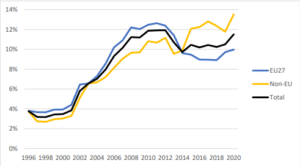In a context where environmental awareness is continuously growing, the demand for eco-friendly products is intensifying. This trend has led to a proliferation of brand names suggesting eco-friendliness. However, it has become difficult for the public to distinguish between brands genuinely committed to environmental efforts and those merely using “green” vocabulary to deceive consumers.
Indeed, in its impact assessment report accompanying the proposal for a Directive amending Directives 2005/29/EC and 2011/83/EU as regards empowering consumers for the green transition through better protection against unfair practices and better information, the European Commission’s Regulatory Scrutiny Board (RSB) noted that over 53.3% of environmental claims analyzed within the EU were found to be vague, misleading, or unfounded, while 42% lacked any tangible evidence. This is why the European Union has taken firm measures to regulate these practices.
The Rise of “Green” Trademarks
More and more consumers are prioritizing eco-friendly products. This growth in demand has pushed brands to reposition themselves, emphasizing their environmental commitments.
Brands have responded to this demand by choosing brand names using environmentally oriented vocabulary and incorporating green colors into their logos. Expressions like “green,” “sustainable,” “eco-friendly,” “natural,” or “biodegradable” are frequently used. This marketing approach, aiming to evoke a positive image and meet growing consumer expectations, is also found in logos incorporating leaves, trees, the planet, or green or blue colors to reinforce this image.
In 2021, a study carried out by the EUIPO through the European Observatory on Infringements of Intellectual Property Rights examined the increasing frequency with which goods and services specification of EUTMs reflect issues related to environmental protection and sustainability. An algorithm was developed to search among the more than 65 million terms contained in EU trademark (EUTM) applications filed over the years to identify those containing at least one “green” term. More than two million EU trademark applications filed with the EUIPO since it began operation in 1996 were considered.
The study shows that the number of “green” EUTM filings has increased significantly since the office began its activities in 1996, both in absolute terms and as a proportion of all EUTM filings.
Green EUTM Filing, 1996-2020 (EUIPO) Green EUTM filings as a share of all EUTM filings, 1996-2020 (EUIPO)
However, trademark registration applications that specifically include direct environmental claims can be refused. These refusals are usually based on the descriptive nature of the mark, although there may also be another reason related to the misleading nature of the trademark.
Therefore, the use of unjustified green trademark will lead to accusations of greenwashing.
Indeed, with the explosion of green marketing, greenwashing practices have also multiplied, attracting the attention of regulators, legislators, and potential litigants such as competitors, customers, or consumer protection organizations.
Greenwashing
Greenwashing is the use of ecological terms or symbols without them corresponding to actual practices. The goal is to give a falsely eco-friendly image to attract consumers. Brands that engage in greenwashing seek to capitalize on the growing market for eco-friendly products without genuinely investing in environmentally friendly practices.
In this context, the European legislator has intervened again with Directive 2024/825 of February 28, 2024, amending Directives 2005/29/EC and 2011/83/EU on unfair commercial practices. This directive is in line with the European Green Deal and the European Circular Economy Action Plan. It aims to “enable consumers to make better-informed business decisions to promote sustainable consumption, eliminate practices that harm the sustainable economy, and divert consumers from sustainable consumption choices.” It creates an action plan for the green transition, targeting greenwashing with three principles. Firstly, brands must be able to prove all their environmental claims. Secondly, the claims must be validated by an independent body. Finally, consumers must receive clear and reliable information. Member States have a 24-month period to transpose the directive into their national laws from March 6, 2024.
France had already introduced provisions to specifically sanction greenwashing statements from January 1, 2023, with Decrees No. 2022-538 and 2022-539 of April 13, 2022, prohibiting advertisements stating that a product or service is carbon-neutral unless a report explaining how carbon neutrality is achieved is published and updated annually.
Greenwashing statements could already be sanctioned on the ground of unfair competition and misleading commercial practices since Law No. 2021-1104 of August 22, 2021, on Climate and Resilience. The new law gives an environmental dimension to the definition of misleading commercial practices.
Conclusion
The proliferation of “green” trademarks names is a natural response to the growing demand for environmentally friendly products. However, greenwashing practices threaten trust in eco-friendly initiatives. To avoid pitfalls and create credible green trademarks, it is essential to follow a transparent strategy, comply with environmental standards, and involve competent experts. The protection of eco-friendly brands and the fight against misleading practices also require increased consumer vigilance and support from lawyers and intellectual property attorneys specializing in this field.
Dreyfus partner with an international network of Trademark attorneys
Have your say: Follow us on social networks!




